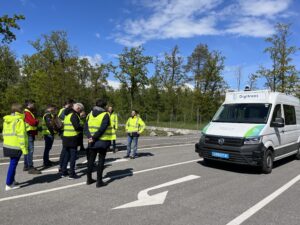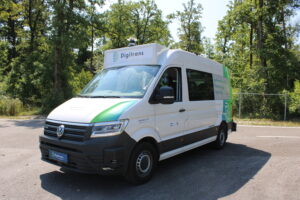AD und ADAS-Tests im Regen auf dem Digitrans Testcenter für autonomes Fahren
SWARCO Road Marking Systems has been a cooperation partner of Digitrans in the field of road marking systems since July 2021.
Since then, SWARCO’s marking experts have been testing at the Digitrans Test Center for Autonomous Driving the extent to which road markings are readable by the sensors of modern vehicles, and this under a wide variety of external conditions.
The Digtrans test center in St. Valentin offers a diverse experimental space for this. Now, after more than one and a half years of cooperation, it is time for an interim conclusion.
We therefore invited Harald Mosböck (Vice President, SWARCO Road Marking Systems Division Europe) and Friedrich Wiesinger (Team Leader Product Development of SWARCO Road Marking Systems) for an interview to ask them about the current state of research in the field of automated driving and the role of road markings.
What tests have already been carried out with SWARCO Road Marking Systems at the Digitrans Test Center for Autonomous Driving?
In the last year and a half, several detection tests were carried out with business partners. Here, we investigated the reliability with which camera and LiDAR sensors can detect the various marking systems on the test center in St. Valentin under different weather conditions and at times of day and night.
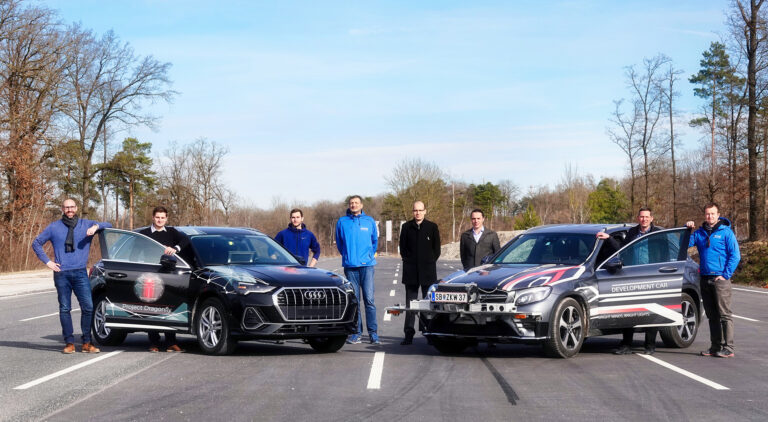
SWARCO Road Marking Systems and the ZKW Group are jointly researching the future of automated driving on the test center in St. Valentin. © SWARCO Road Marking Systems
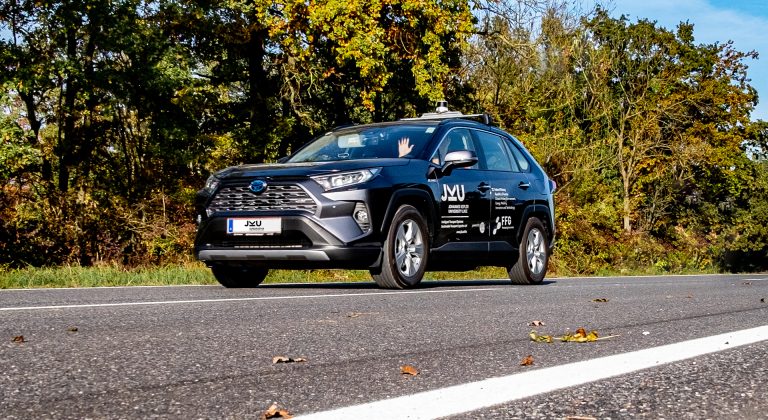
Together with the professorship of Sustainable Transport Logistics 4.0 at JKU Linz, LiDAR and cameras were tested, including for the detection of the surroundings and road markings. © Professorship of Sustainable Transport Logistics 4.0 Johannes Kepler University Linz
What are SWARCO Road Marking Systems' goals with the tests at the Digitrans Test Center in St. Valentin?
With the tests and measurements on the Digitrans test center in St. Valentin, we are primarily pursuing the goal of gaining far-reaching insights into the conditions under which the sensor systems of modern vehicles can detect road markings and thus pave the way for automated driving. The aim is to gain scientific insights into the detectability of existing standard and premium marking systems by state-of-the-art sensors. This should help to arrive at minimum standards for the quality of road markings so that automated driving works reliably. We were able to demonstrate that wider and higher retroreflective premium markings are more reliable to detect and thus contribute to greater road safety.


Premium textured markings increase visibility and safety on the road, even for automated driving.
© SWARCO Road Marking Systems
What experience was gained during the tests on the test center in St. Valentin?
Initial findings on the machine readability of road markings have already been published in scientific papers and press articles. On the Digitrans test center in St. Valentin, for example, standard and premium marking systems were tested in wet conditions using cameras and LiDAR.
Especially the outdoor rain plant on the test center in St. Valentin helped us to investigate the detectability of different marking systems for camera and LiDAR systems in different reproducible scenarios at different precipitation intensities.
This gave us interesting results in a very short time. For example, heavy rain has a great influence on the functionality of the sensor systems and marking systems. It also became very clear that structured markings with premium reflective glass beads are much more visible to the camera, LiDAR and the human eye at night and in wet conditions.

Impressions from the tests at the Digitrans Test Center for Automated Driving. © SWARCO Road Marking Systems
Your thoughts on the vision of automated driving in Austria. What could it look like on our roads in the future, and what is your contribution to it?
In the next decade, we will be talking about assisted driving, as fully automated vehicles in Europe hardly seem feasible in the near future for various reasons.
SWARCO’s contribution here is to create optimal readability conditions, for example, for the lane departure assistants of modern vehicles, through highly visible road markings in all possible weather conditions. Here, our high-performance markings in the form of Type II structural markings make a significant contribution. For the greatest possible safety, both from the perspective of the assistance systems and that of the human driver, it would therefore be desirable to have such markings on all high-priority roads.
Where do you see the biggest challenges in the coming years in the area of automated driving in combination with marking systems?
The greatest challenges include borderline cases due to weather conditions, such as blinding low sun, heavy rain, snowfall or ice, which severely limit the visibility of markings. In such cases, the vehicles’ sensors are sometimes “blind.”
Premium markings and very high-contrast markings are a prerequisite for reliable driving under these conditions. On the vehicle side, the combination of several detection systems (camera, LiDAR, radar, etc.) helps here.
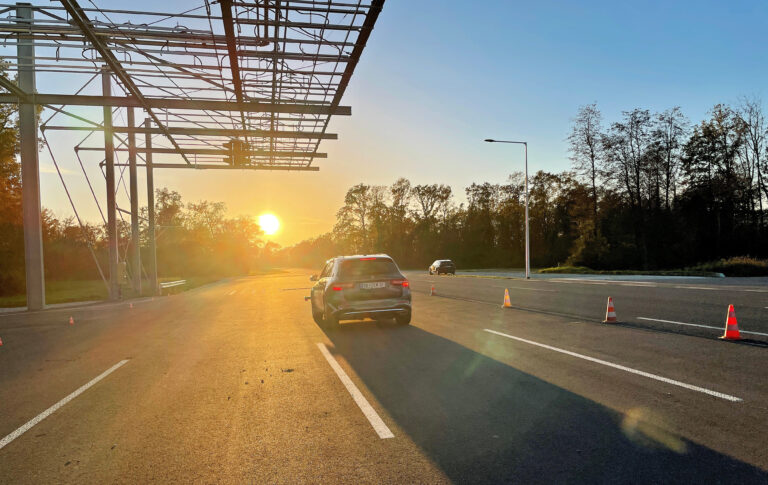
Low sun glare at Digitrans autonomous driving test center. © SWARCO Road Marking Systems
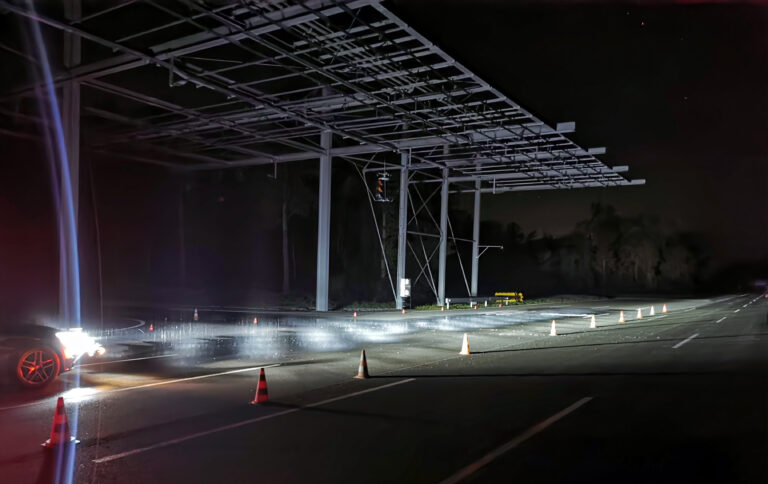
Simulated rain on the outdoor rain plant at Digitrans © SWARCO Road Marking Systems
How is Digitrans supporting you in your venture, and what do you particularly like about working together on the test center in St. Valentin?
On the Test Center for Automated Driving in St. Valentin, Digitrans has created ideal conditions for testing automated driving with various reproducible functionalities. Both different weather conditions and a variety of traffic scenarios can be tested there safely and reproducibly, making the Digitrans test area particularly valuable for our research priorities.
For example, the City Zone and the recently constructed outdoor sprinkler system provide constant conditions for complex and reproducible test scenarios.
Added to this is the support of experts from industry and a specially developed automated test vehicle, which will also be on public roads in Austria in the future.

Impressions from the Digitrans Test Center for Automated Drving in St. Valentin © DigiTrans GmbH
Are there plans for future projects in the field of automated driving?
In the future, joint tests of automated vehicles on the test track in St. Valentin, but also on public roads, will be of interest. In particular, the Digitrans eVAN automated test vehicle developed by Digitrans can provide interesting measurement data of marking systems here – and also outside the usual “laboratory environment” of a test track. The move onto public highways, country roads and into cities will be the next important test step towards automated driving.
Interviewpartner:

Harald Mosböck
Vice President Region Europe – SWARCO Road Marking Systems

DI Dr. Christoph Feichtinger
Team Leader Product Development - SWARCO Road Marking Systems
You might also be interested in
Further Insights
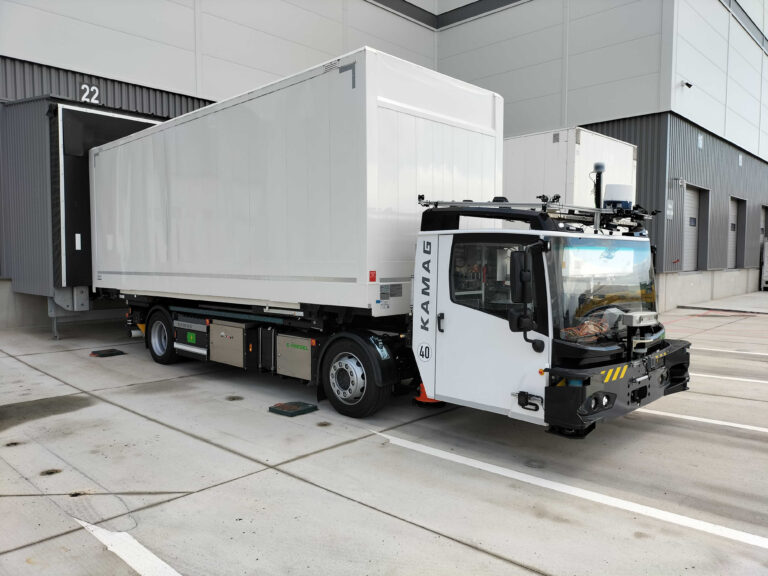
AWARD H2020 – Start of test operation for automated freight transport in Gunskirchen, Upper Austria
Start of the test phase in public transport in Gunskirchen. On the approximately 600m long route between the two companies BRP-Rotax and the freight forwarder DB Schenker Austria, an automated electric truck with test approval will be tested in real operation from June 12, 2023.

EU Project AWARD H2020 – Challenges in automated freight transport
On the way to automated freight transport – Insights on the AWARD H2020 project. Digitrans project manager Hannes Watzinger provides insights into the three most important challenges during deployment.
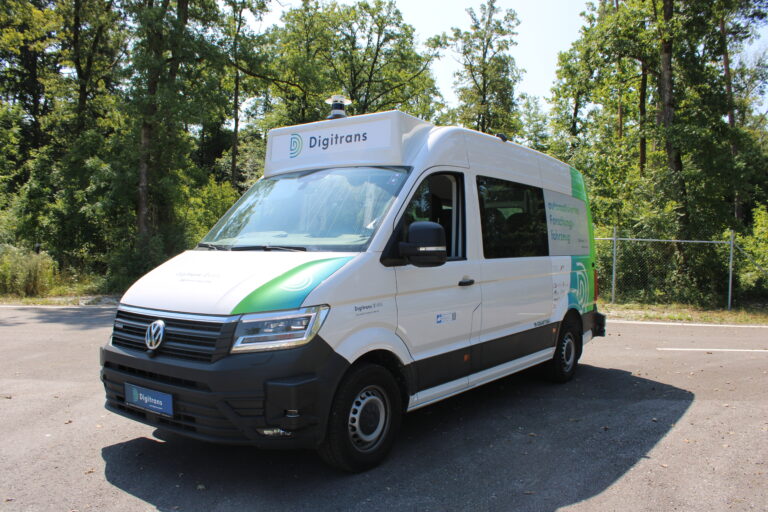
Digitrans eVAN – automated test vehicle level 4
The vehicle is equipped with the latest technology and is already able to drive most of its journey independently. It can be used both as a passenger and goods transporter.


